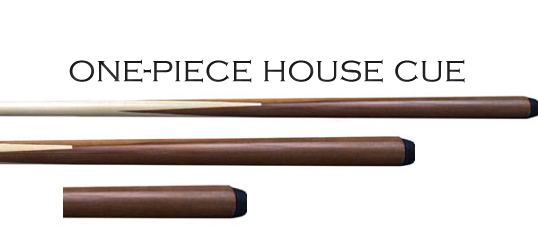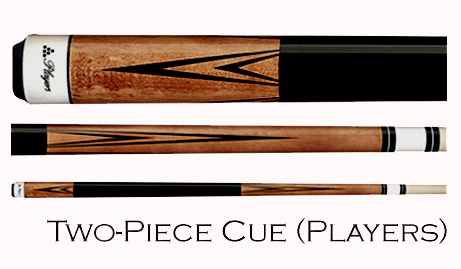Author: Curt Riedy
We strongly encourage any reader who finds this information beneficial to share it with their friends or other interested parties. Our readers are encouraged to link to this article from their own websites.
It doesn't matter if you're on your first or fifteenth pool cue purchase, a buyer should always be conscious of the most reliable brands and models that can suit their playing needs. On top of that, we find that it's also extremely important to be aware of the specific types of cues that are out there, and what exactly each one of them does.
Now, if you’re new to the game, the ideal cue you should be looking for is a bare-bones model with a solid hit. Still, in order to develop into an experienced player, exploring the different cue options should definitely be on your “to-do” list. Different cues serve different purposes, and their unique traits are what make them specifically useful for various types of game-play.
Types of Cues:
Here’s a quick breakdown of the unique cue variations we’ll be exploring in this article:
| Types of Cues | ||
| One-Piece | A general, uniformed stick for the common player. | |
| Two-Piece | A more advanced cue that can be quickly disassembled. | |
| Two-Piece “Jump Cue” | A multi-functional cue perfect for breaking, jumping, etc | |
| Sneaky Pete | A high-quality cue w/ a rudimentary look to fool opponents. | |

The most general of pool sticks is the One-Piece Cue, which is often seen used in pubs and bar rooms by the common player looking to play a quick game. These cues have a uniform taper that maintains an even length from butt to tip.

More common amongst pros and pool enthusiasts is the Two-Piece Cue, a pool stick that can be quickly disassembled, providing easy transport for on-the-go players that often travel with cue cases to protect their equipment. Trust us, if you’re a player who enjoys playing out at the billiards hall with your favorite cue, you probably want to avoid the laughs and finger pointing that will occur when you walk in with your 70inch pool stick fully extended. Available in various weights and functions, several versions of the two-piece cue exist in the billiards market.

One two-piece cue that can currently be found on the market features a joint three quarters down the cue (12-16 inches away from the butt), and is typically referred to as “The Jump Cue”. In fact, this particular cue (which can even go up to three to five pieces), is known for its perfect abilities in breaking, jumping, changing weights, or adding butt extensions that provide a longer reach. Oftentimes, these intermediate cues contain interchangeable screw-in tips that change the path and ultimate impact of the cue ball.

Another popular cue is the Sneaky Pete, a high-quality two-piece cue that strongly resembles a bare-bones, one-piece bar cue. The least costly of the two-pieces, these cues earn their name from their common use in hustling strangers in local bars and billiards halls. Thanks to its raw look, the cues have the ability to fool an opponent into thinking their competitor is a foolish first-timer, allowing the hustler to slowly begin dominating the table. Outside of bar-room hustling, Sneaky Pete’s are often used as a break cue by tournament players due to their inexpensive nature.
Materials Used:
The two primary types of material used to construct these various types of cues are fiberglass/graphite and wood. A good number of the more serious players opt for wood, but fiberglass/graphite is resistant to warping and some other maintenance issues. Wood-to-Wood Cues, such as McDermott, provides the softest, most fluid hit, and tend to be the most ideal for beginners.
If you're looking for a cue with a fiberglass shell that will provide additional protection against dents and warping, Cuetec and Scorpion also provide plenty of models that will serve your interest.
Types of Shaft:
Little debate is necessary; the shaft is quite possibly the most important part of the cue. A truly decent shaft is one that consists of a body made from the most durable of woods, North American Hard Rock Maple. Any cue without one is most likely an inferior product. The size of a shaft generally ranges from 12mm to 14mm, with 13mm being the most popular amongst pro players. The smaller the diameter of a shaft, the more it will “flex” and cause greater deflection in your shot.
Within different cue types, you’ll also find that the shaft consists of various types of tapers, the cue’s gradual diminution of width or thickness. The two most common tapers are the Pro which has the same diameter from the tip to 30-35 cm (12-14 inches) down, and the European, which is conical and widens towards the joint.
The end of the shaft also features a cuff known as the ferrule which is intended to hold the cue tip in place. The ferrules you’ll find in the more popular brands are often made of ivory, carbon fiber, or a plastic such as melamine resin, aegis or phenolic resin, a material that is extremely durable and crack-resistant.
To Wrap or Not to Wrap:
Another consideration to choosing the right shaft is whether to purchase a cue that includes a wrap. If your hands tend to perspire more often than you would like, you’ll definitely appreciate a pressed Irish or linen wrap to avoid slipping and missing that valuable shot. A quality wrap is also important for players who are looking for a stiffer shaft.
It’s also important to take note that a cue featuring vinyl or rubber instead of a wrap is more or less useless in terms of providing a solid grip. While it’s generally more convenient to purchase a shaft with a wrap included, they can be purchased and applied to previously unwrapped models.
The Importance of Weight:
An incredibly important thing to realize is that there isn’t one perfect weight that exists for all billiards players. The correct weight of a cue depends solely on the player using it.
Most cues are weighted between 18 and 21oz. Some are more comfortable with a light cue while others are only happy playing with a heavy cue. What’s right for one person isn’t necessarily the right cue for another.
That being said, the most common weight for a pool cue of any kind is 19oz. It should be noted that a heavier cue will not always mean a more powerful hit or break, and in fact, may create less power depending on the amount of force you create. What’s most important in the process of cue selection is choosing the weight that feels the most comfortable to you.
Several cues are weighted with a bolt in the butt of the cue, which is perfect for the beginner who wants the option of changing weight sizes as their performance develops.
For even more helpful instructions on purchasing a pool cue, please take a look at the informative guide entitled How to Buy a Pool Cue, located in our Billiard Resource Center.